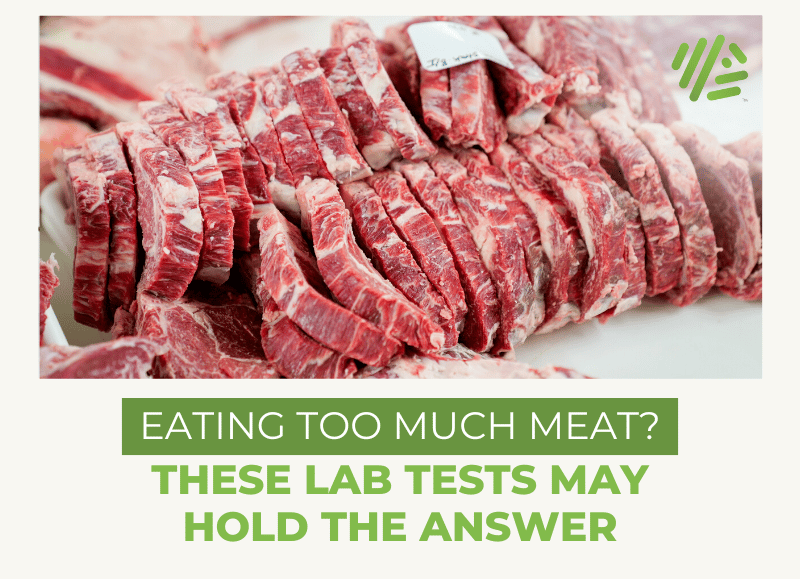Eating Too Much Meat on a Carnivore Diet? These Lab Tests May Hold the Answer
Article at a Glance
- Almost all nutrition and medical experts agree that the meat only carnivore diet is unhealthy and could do lasting harm.
- For those eating large amounts of animal protein, blood testing may help reveal when they have gone too far.
- Serum ammonia, ApoB, IGF-1, and cRP are all tests to discuss with your doctor if you’re concerned a meat heavy diet maybe causing a decline in your health.

Contents
While the emerging scientific consensus from researchers like Dr. Valter Longo at USC seems to be to reduce meat intake for optimal health (especially before the age of 65) no two people respond in exactly the same way to eating meat.
In the table below, we share a quick rundown on the protein preferences of Dr. Peter Attia, who believes meat can be incorporated as part of a healthy diet, and Dr. Valter Longo, who leans much more plant based. It should be noted that neither physician advocates for a carnivore diet, which is a risky protocol that can harm long term health.
Attia vs. Longo on Daily Protein Needs
| Issue | Attia | Longo |
|---|---|---|
| Ideal Intake | ~2.2 g per kg body weight (~1.0 g/lb) | ~0.8 g/kg (<65 yrs) (~0.36 g/lb), ~1.0 g/kg (≥65 yrs) (~0.45 g/lb) |
| 155 lbs person | 154 grams per day | ~56 grams/day (<65 yrs) ~70 grams/day (≥65 yrs) |
| Source | Animal based | Plant based |
| Philosophy | Need muscle mass as we age | Lower IGF-1 to reduce aging/cancer risks; more protein after 65 to protect muscle |
| Goal | Strength maintenance | Longevity, cellular protection |
Is eating meat healthy?
There is a lot of contradictory information on the internet about eating meat. Even a quick review of the latest studies can be frustrating. For example, the controversy surrounding a study published in the Annals of Internal Medicine (November, 2019) which did not find a link between increased red meat consumption and disease risk. But then you have this Harvard Study which found that a plant based diet reduced all cause mortality in just 18 months in people suffering from a chronic illness.
However, healthy members of the group showed no detriment from eating meat. The benefits of the plant based diet were found only in those who were already sick. What does the latest science mean for you, the reader? The important questions are:
- How much meat do you eat?
- Where does that meat come from?
- What type of meat is it?
- What do important biomarkers look like for you when eating a diet that includes more meat?
Is eating meat one of the factors that can contribute to an increased risk for cancer and heart disease, especially in some people? Yes, it appears certain people don’t do as well with meat heavy diets. So, how can we tell if we are eating too much meat? Below, I list some of the biomarkers you’ll want to discuss with your doctor to determine whether you might be eating too much meat.

Unlock Your Personalized Nutrition & Supplement Report
Gene Food uses a proprietary algorithm to divide people into one of twenty diet types based on genetics. We score for cholesterol and sterol hyperabsorption, MTHFR status, histamine clearance, carbohydrate tolerance, and more. Where do you fit?
Meat eaters: know your numbers for these lab tests
Serum ammonia
Metabolizing protein leaves behind waste in the form of ammonia. If you have too much ammonia in the blood, it may be a sign that you are eating too much protein. John has written in pervious blog posts about the urea cycle, the metabolic process our bodies use to convert the organic nitrogen in animal protein into urea, a substrate we can get rid of in the urine. Genetically, some of us do a great job of getting rid of ammonia and urea, however, not everyone is so lucky. Diminished urea cycle metabolism means diminished protein metabolism.
A meat heavy diet won’t work for people who do a poor job metabolizing protein waste and a simple ammonia blood test may clue you in to a problem you didn’t know you had. For more information on urea cycle disorders, have a look at the UCD in Common website.
ApoB (heart health)
More than any other metric, the risk for heart disease is driven primarily by your total number of lipoproteins, known as the LDL particle count, or just LDL-P. 1 Lipoproteins carry fats around the body. The more of these “fat taxis” on the road, the greater chance they crash into an artery wall which triggers the inflammatory reaction that leads to heart disease over the long term.
While a diet high in sugar can cause unhealthy levels of ApoB, so too can a diet that is high in saturated fat. Meat products are among the highest saturated fat foods. If you tend to see high LDL-C and high LDL-P, it could be a sign that your body is making or absorbing more cholesterol in response to your high meat (high fat diet). It doesn’t happen in all people, but in some with genetic predispositions, eating a diet high in saturated fat can cause cholesterol numbers to reach unhealthy levels. If your LDL-C and LDL-P are high, it could be a sign it’s time to incorporate more plant proteins. Note: since there is one Apolipoprotein B (“APOB”) for every LDL-P (as well as VLDL and IDL), an APOB test is just as good as LDL-P.
TMAO (gut health)
We’ve already written on this blog about a gut metabolite called trimethylamine-N-oxide, or “TMAO” for short, that the New England Journal of Medicine has linked to heart disease. The microbiome naturally produces TMAO when we eat carnitine, an amino acid found in fish and meat, as well as fats like choline, which is found in high amounts in egg yolks as well as certain supplements. This post discusses how variants in a gene called FMO3 could be responsible for elevated TMAO levels in some carriers. Others have speculated that elevated TMAO levels could be the sign of a microbiome that is out of balance.
The bottom line is this: the study linking TMAO to heart disease is very credible, but it is now without its critics. For example, most of the longest lived people in the world incorporate fish in their diets. We don’t know the FMO3 status of the people in the blue zones, and most of these populations haven’t been exposed to the microbiome challenges that we in the western world have to deal with as the result of widespread antibiotic use. In other words, the microbiome changes in response to lifestyle factors and the best way to determine whether you carry the strains of bacteria that produce TMAO is to test. If TMAO levels are high, it may be a sign you’re eating too much meat and that your microbiome is out of balance.
See also: Can undigested protein lead to leaky gut?
IGF-1 (cancer risk)
Part of the reason eating meat is said to be inflammatory is because the amino acid profile in meat spikes a hormone called insulin like growth factor, or IGF-1, which our bodies need to grow muscle cells, but also to grow “bad” cells, like cancer cells. Research from Dr. Valter Longo, head of longevity at USC, has looked at how certain amino acids, such as methionine, especially when consumed in animal protein where they are most bioavailable, increase IGF-1 levels, which in turn activates a pathway in the body called mTOR, which is the cancer and aging pathway. 2 Dr. Longo advocates for eating fish and certain dairy products, especially after age 65 when seniors begin to risk frailty on a completely plant based diet. In these cases, Longo recommends seniors eat fish and some goat and sheep dairy, because their IGF-1 levels can become too low. And the little known “IGF-1” is at the heart of the meat and disease link. So, yes, the plant based community is correct when they say that eating meat can cause, or accelerate cancer growth, but the amount of meat eaten, as well as the starting IGF-1 levels of the person eating it, play a role as well. Longo is saying IGF-1 can go too high, but it can also go too low. Your doctor can order a lab test to see where your IGF-1 levels are. If they come back high, you may want to consider eating less meat.
C-reactive protein (generalized inflammation)
As the name indicates, C reactive protein, or “CRP,” is a protein that, when elevated above 10 mg/dl in the blood, is thought to be a sign of inflammation in the body. The high sensitivity CRP (“hsCRP”) test, which, as the name suggests, is a more sensitive CRP test, is used in patients with an increased risk for heart disease. According to the Mayo Clinic, high levels of CRP can be a sign of a diverse range of conditions, ranging from chronic infection, to autoimmune conditions like Rheumatoid arthritis, to heart disease. While high CRP doesn’t necessarily mean you’re eating too much meat, research does indicate that meat consumption can have an inflammatory impact on the body and an excess of animal protein could be one of the culprits behind elevated CRP. 3
Advanced labs like Function Health report on CRP and it’s also an option to have your physician order the test as well (which is more likely to be covered by insurance).

Gerald Dropped His LDL-C by 100 Points With Diet Alone
Gerald was an ultramarathon runner, but despite his dedication to fitness, he was struggling with rising cholesterol levels, increasing blood pressure, and low energy.
Conclusion
Of course, the list I offer above isn’t exhaustive. A good doctor will give you a more thorough workup than just these 5 lab tests. The takeaway is clear: no two people react exactly the same way to a given diet. We must individualize everything and that starts with knowing your numbers for key biomarkers.
Are you healthy as a meat eater? I don’t know. The issue comes down to genetics, the type of meat being consumed, and how much is consumed. There is no easy answer. The best course of action is to get regular blood work so you know where you stand and have a better idea as to whether the amount of meat you are currently eating is healthy for you.



